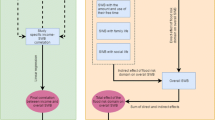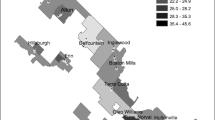Abstract
Benefit-cost analyses are required for proposed flood alleviation and sea defense schemes in the United Kingdom. However, generally flood impacts such as stress, worry and evacuation have been left as ‘intangibles’. Economic theory predicts that the avoidance of such impacts is a real benefit of flood alleviation. But only those impacts for which there exist a value concensus as to the bases of their measurement can be included within the framework of economic efficiency benefit-cost analyses.
In recent benefit-cost analyses we have, therefore, employed exploratory procedures to measure worry, health damage and other traditionally ‘intangible’ flood losses. A method of deriving the monetary equivalents of these impacts has also proved both feasible and to have face validity. The magnitude of these losses generally exceeds the physical damage caused by flooding.
Since worry has been shown to correlate with perceived risk, such evaluations include willingness-to-pay to reduce risk to health and safety. Estimating the risk to life in a particular location is problematic since the risk is almost wholly a function of the behavioural choices made by those at risk. Results of several studies of behavioural response to warnings and to discovering water are discussed.
Access this chapter
Tax calculation will be finalised at checkout
Purchases are for personal use only
Preview
Unable to display preview. Download preview PDF.
Similar content being viewed by others
References
Antle, G., 1977. “Analysis of property value to determine the impact of flooding” in Proceedings of the Social Scientists Conference, Memphis, US Army Engineer Institute for Water Resources: Fort Belvoir, Virginia.
Bennet, G., 1978. “Bristol Floods 1968, Controlled survey of effects on health of local community disaster”, British Medical Journal, 3, 454–458.
Bayrisches, Landesamt fur Wasserwirtschaft, 1983. Nutzen-Kusten- Untersuchung zur Teilruckleitung der Oberen isar Munich.
Canter, D., Breaux, J. and Sime, J., 1980. “Domestic, Multiple Occupancy and Hospital Fires” in Canter, D. (ed.), Fires and Human Behaviour, John Wiley“ Chichester.
Chatterton, J.B., Pirt, J. and Wood, T.R., 1979. “The benefits of flood forecasting”, Journal of Institute of Water Engineers and Scientists, 33 (3), 237–52.
Dalderfield, E.R., 1976. The Lynmouth Flood Disaster, ERD: Exmouth. Dreze, J., 1962. “L’utilite sociale d’une vie humane”, Rev. Fr. Rech. Oper., 6 (23), 93.
Emery, P.J., 1984. “Health affects of flooding” in Handmer, J. (ed.) Proceedings of an Invitational Workshop, International Flood Research: Lessons for the UK, Geo Brooks: Norwich (in press).
Fishbein, M. and Ajzen, I., 1975. Belief, Attitude and Behavior, Addison-Wesley: Reading, Mass.
Green, C.H., 1980. “Revealed preference theory: assumptions and presumptions” in Conrad, J. (ed.), Society Technology and Risk Assessment, Academic Press: London.
Green, C.h., 1984. “Not looking under lampposts: benefit-cost analysis and social values” in Handmer, J. (ed.), Proceedings of an Invitational Workshop, International Flood Research: Lessons for the UK, Geo books: Norwich (in press).
Green, C.H., Brown, R.A., and Goodsman, R.W., 1983. The Perception and Acceptability of Risks, Building Research Establishment Note N7/83, Fire Research Station: Borehamwood.
Green, C.H., Emery, P.J., Penning-Rowsell, E.Ç. and Parker, D.J., 1984. The health effects of flooding: a survey at Uphill, Avon, Flood Hazard Research Centre, Middlesex Polytechnic.
Green, C.H., Parker, D.J. and Emery, P.J., 1983. The Real Cost of Flooding to Households: Intangible Costs, Geography and Planning Paper No. 12, Middlesex Polytechnic.
Green, C.H., Parker, D.J., Thompson, P.M. and Penning-Rowsell, E.C., 1982. Indirect losses from urban flooding: an analytical framework,Geography and Planning Working Paper No. 6, Middlesex Polytechnic.
Green, C.H. and Penning-Rowsell, E.C., 1983. Western Enfield Flood Relief Scheme: An extended assessment of selected benefits, Flood Hazard Research Centre, Middlesex Polytechnic.
Grist, D.E., 1978. Individual risk - a compilation of recent British data, SRD, R125, London: HMSO.
Gruntfest, E.C., Downing, T. and White, G.E., 1978. “Big Thompson flood exposes need for better flood reaction system to save lives”, Civil Engineering, February, 72–3.
Harding, D.M. and Parker, D.J., 1974. “Flood hazard in Shrewsburg, UK” in White, G.E. (ed.) Natural hazards local, national and global, Oxford: New York.
Holmes, T.H. and Rahe, P.H., 1968. “The Social Readjustment Rating Scale”, Journal of Psychosomatic Research, 11, 213–218.
Jones-Lee, M., 1969. “Valuation of reductions in probability of death by road accident”, Journal of Trans. Eco. Policy, 3, 37.
McKenna, S.P., Hunt, S.M. and McEwen, J., 1981. “Weighting the seriousness of perceived health problems using Thurston’s method of paired comparisons”, International Journal of Epidemiology, 10 (1), 93–97.
Mishan, E.J., 1971. “Evaluation of Life and Limb: a Theoretical approach”, Journal of Political Economy, 79, (4), 687.
Parker, D.J., Green, C.H. and Penning-Rowsell, E.C., 1983. Swalecliffe Coast Protection Proposals: Evaluation of Potential Benefits, Flood Hazard Research Centre, Middlesex Polytechnic.
Parker, D.J., Penning-Rowsell, E.C. and Green, C.H., 1984. Whitstable Central Area Sea Defense Scheme: evaluation of potential benefits, Flood Hazard Research Centre: Middlesex Polytechnic.
Pearce, D.W., 1978. “Noise Nuisance” in Pearce, D.W. (ed.) The Valuation of Social Cost, Allen and Unwin: London.
Penning-Rowsell, E.C., Parker, D.J. and Green, C.H., 1984. Loughton Brook Improvement Scheme: Assessment of potential benefits, Flood Hazard Research Centre: Middlesex Polytechnic.
Penning-Rowsell, E.C. and Chatterton, J.B., 1977. The benefits of flood alleviation: a manual of assessment techniques, Saxon House: Farnborough.
Penning-Rowsell, E.C., Chatterton, J.B., and Witts, R.C., 1983. An “intermediate” updating of the Middlesex Polytechnic standard potential flood damage data, Flood Hazard Research Centre, Middlesex Polytechnic.
Robinson, D.N., 1971. The Book of Louth, Barracuda: Buckingham. Royal Society, 1983. Risk Assessment - A Study Group Report, Royal Society: London.
Schmidtke, R., 1984. “Project Appraisal, Resource Allocation and Public Involvement” in Handmer, J. (ed.) Proceedings of an invitational Workshop, International Flood Research: Lessons for the UK, Geo Books: Norwich (in press).
Sterland, F.K., 1973. “An evaluation of personal annoyance caused by flooding” in Penning-Rowsell, E.C. and Parker, D.J. (eds.) Proceedings of a Symposium on the Economic Aspects of Floods, Middlesex Polytechnic.
Sugden, R. and Williams, A., 1978. The Principles of Practical Cost-Benefit Analysis, University Press: Oxford.
H.M. Treasury, 1982. Investment Appraisal in the Public Sector, HM Treasury: London.
Wood, D.G., 1972. The Behaviour of People in Fires, Fire Research Note No. 953, Fire Research Station: Borehamwood.
Author information
Authors and Affiliations
Editor information
Editors and Affiliations
Rights and permissions
Copyright information
© 1987 Plenum Press, New York
About this chapter
Cite this chapter
Green, C.H., Penning-Rowsell, E.C., Parker, D.J. (1987). Estimating the Risk from Flooding and Evaluating Worry. In: Covello, V.T., Lave, L.B., Moghissi, A., Uppuluri, V.R.R. (eds) Uncertainty in Risk Assessment, Risk Management, and Decision Making. Advances in Risk Analysis, vol 4. Springer, Boston, MA. https://doi.org/10.1007/978-1-4684-5317-1_14
Download citation
DOI: https://doi.org/10.1007/978-1-4684-5317-1_14
Publisher Name: Springer, Boston, MA
Print ISBN: 978-1-4684-5319-5
Online ISBN: 978-1-4684-5317-1
eBook Packages: Springer Book Archive




